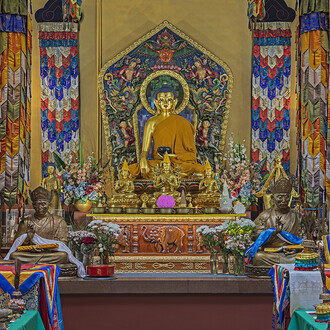Vik Muniz is a world-renowned artist and photographer working in Rio de Janeiro and New York. Muniz began his artistic career as a sculptor, but later shifted his focus to graphic arts and photography. Inspired by the work of postmodernists Cindy Sherman and Jeff Koons, Muniz uses popular images in his works and presents them in a new way, thus demonstrating one of the fundamental ideas of contemporary art: the primacy of concept over uniqueness of visual context.
Experimenting with a wide range of non-traditional materials (dry pigments, dust, sugar, chocolate, diamonds, caviar, children's toys, garbage, scraps of magazines), Muniz reproduces the works of famous artists, creating short-lived copies of iconic pieces of art. Artist captures the results of his work in series of high-resolution photographs, rediscovering the masterpieces of Van Gogh, Picasso, Malevich, Klimt, Mondrian and Matisse.
Muniz not only acquaints the viewer with the phenomenon of appropriation in photography, but also with the idea of using new techniques in creating works of art, raising the question of the primacy of an idea and the various forms of expression. He calls himself "an observer of the skirmish between structuralist and poststructuralist criticism".
Muniz is convinced that art should change the world for the better and should not be elitist at all. He seeks to make it more accessible. Through the implementation of unexpected techniques and thoughtful visual puns, his works capture the interest of any viewer, from connoisseurs of museum classics to a younger audience. The apparent ease of presentation of complex images turns his work into a kind of conduit to a new world of art and technology, inextricably linked to the achievements of early master artists and art history in general.
Time magazine named Muniz one of the leading artists of the new millennium and the New York Times has recommended his work as a sure-fire antidepressant, describing it as “an idea wrapped in surprise and laughter.” However, in addition to humor in the works of Muniz, there is also a deeper social implication: he draws the public’s attention to global issues, such as pollution and the difficult living conditions of the low-income population of Brazil.
His documentary "Waste Land" (2010) was nominated for an Oscar and won several prizes at the Toronto, Berlin and Sundance film festivals. It chronicles the largest landfill in the world, "Jardim Gramacho" on the outskirts of Rio de Janeiro. After auctioning off his series, "Pictures of Garbage", in the UK, Muniz donated the proceeds to the Garbage Pickers' Association of Jardim Gramacho, which marked the beginning of his extensive charitable work.
Vik Muniz participates in many educational and social projects in Brazil and the United States. In 2011, he was appointed as a UNESCO Goodwill Ambassador. In 2014, Vik began construction of Escola Vidigal, a school of art and technology for children from low-income families in Rio de Janeiro, and in 2015 his series "Colonies" was featured in the Gates Foundation project "The Art of Saving a Life".
Muniz lectures at major universities and museums around the world, such as Oxford, Harvard and Yale Universities; The Museum of Modern Art (MoMA), New York; and The Museum of Fine Arts in Boston, as well as in public venues, including TED conferences, The World Economic Forum, an internship program at the Massachusetts Institute of Technology and the Skowhegan School of Painting and Sculpture.
The works by Vik Muniz have been presented in collections of such museums as the Victoria and Albert Museum (London), Tate (London), the Museum of Modern Art (MoMA) in New York, the Guggenheim Museum (New York), the Metropolitan Museum of Art (New York), the Whitney Museum of American Art (New York), the Museum of Fine Arts (Boston), the Art Institute of Chicago, the Menil Collection Museum (Houston, USA), the Museum of Contemporary Art in São Paulo, the Museum of Modern Art in Rio de Janeiro (MAM), the Museum of Contemporary Art of Rome (MACRO), the Irish Museum of Modern Art (Dublin), the Joan Miró Foundation (Barcelona), the Tel Aviv Museum of Art, the Long Museum (Shanghai) and the Museum of Contemporary Art Tokyo.












